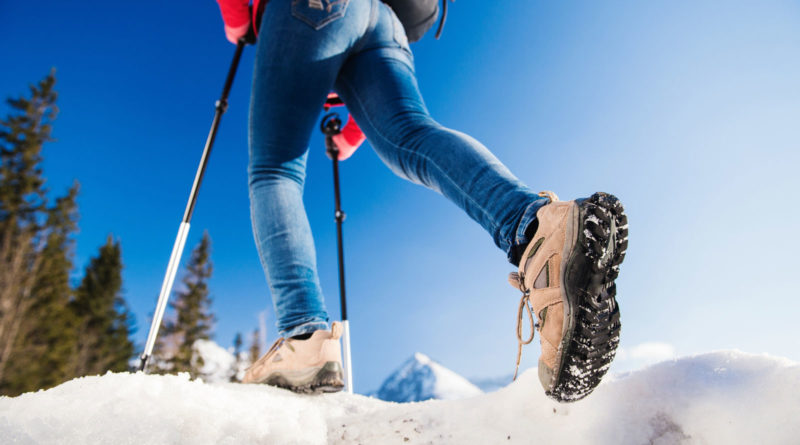Can you wear Hiking Boots in the Snow?
Let’s say you have a nice pair of hiking boots that you wear all the time in summer. You are in love with those shoes but now, winter has come and you are thinking to yourself if you can wear them in the snow. The short answer is that you can wear your hiking shoes in the snow if they are waterproof and you don’t have to walk in deep snow.
Hiking boots can be used with gaiters and warm socks for the insulation and warmth that snowshoes provide. However, there are boots designed specifically for hiking in the snow. They are usually waterproof and can still be combined with gaiters and crampons to increase their waterproofing capability which is helpful while in the snow.
How to use Hiking Boots in the Snow?
Technically, you can use your hiking shoes in the snow depending on the activity and the weather you will be up against. Here are some ways you can use any pair of boots in the snow depending on the weather.
1. Light snow
Any outdoor footwear is going to work great with light snow on the ground. Boots that provide better traction are always preferable to use in light snow. Boots primarily designed for hiking will work fine for a moderate amount of snow as well. In slippery conditions, microspikes like the Kahtoola MICROspikes and other traction devices such as Kahtoola NANOspik can be used. Microspikes are very helpful while climbing inclines.
2. Deep Snow
If you are taking your hiking boots out in the deep snow deeper than an inch, make sure they’re waterproof. There are a lot of waterproof boots on the market but if your boots aren’t waterproof, you can use a waterproof spray such as the Apple Brand Garde or other such products like the Rust-Oleum NeverWet to make them at least water repellent.
If the snow is deeper than an inch, you should probably bring along your snowshoes because they have a few advantages over regular hiking boots. Still, gaiters like Outdoor Research Rocky Mountain Low Gaiters can be used with hiking boots to keep the feet and the lower legs warm and prevent snow from entering the boots.
3. Keep your Feet Warm
When you hike in the snow, make sure you wear well-insulated socks to keep your feet warm. If you have room in your boots, wear two pairs of socks. Two layers are going to provide more warmth and a thicker layer also prevents blister formation. This is especially helpful if you are standing for too long. The Smartwool Trekking Heavy Crew Socks is an example of a nice pair of warm socks.
Snow Boots vs. Hiking Boots
Hiking boots are sturdier than snows boots and provide more protection to the feet. They also support more ankle support and more traction on uneven ground. They are a better choice for light to moderate snow and a lot of people prefer them over snow boots.
Snow boots, on the other hand, are a better choice for a lot of snow. They are adequately insulated and keep the feet warm. These boots are specifically useful in a lot of deep snow that hasn’t been packed yet. They allow walking over the snow instead of sinking in making it easier to walk in such conditions.
However, snow boots are less sturdy making them less safe against injuries. They are also less comfortable for walking for longer periods and provide less traction on uneven and slippery icy surfaces. Wearing waterproof hiking boots with warm wool socks as mentioned above can compensate for the insulation that snow boots provide. People use snow boots in deep snow and only if they are waterproof. Otherwise, hiking boots are a better choice.
All in all, it comes down to your activities. If you will be walking on a lot of trails or in the city with short stops and light snow then hiking boots are a better option. Snow boots can be used in glacier hiking, and even then, they can be rented from the tour operators and don’t need to be bought.
Winter Hiking Boots
If you prefer the protection and traction of a hiking boot and you are willing to wear them even in the winter season or snow, get a pair of winter hiking boots. You get the benefits of hiking boots with the insulation of snow boots. Here are some of the key features that why people prefer winter hiking boots over snow boots.
1. Sturdiness
Winter hiking boots are stiffer and heavier and provide more versatility over uneven and tough terrain. Many winter hiking boots have extended ankles to provide more support over slippery and icy terrain. The rubber soles of these boots provide plenty of traction.
These differences can be seen in a side-to-side comparison between snow boots and hiking boots. Snow boots lack ankle support but are more flexible. The extended ankles of the hiking boots prevent snow from entering the boots. Once the snow gets inside the boots, it causes the socks to become wet leading to painful pressure areas and even frostbite if the temperature is too cold outside.
2. Waterproofness
You certainly don’t want your feet to get wet in winter as it can cause frostbite. Frostbite is the freezing of the skin and tissue. It is painful and requires medical treatment. When it comes to hiking boots, both, water-repellent and waterproof options are available on the market but there is a difference between both.
Water-repellent material has a shorter lifespan. The more the shoe is used in water, the quicker the water-repellent layer will wear out. Waterproof, on the other hand, keeps the water out completely and is a more long-lasting option. Waterproof hiking boots may compromise on breathability but materials like Gore-Tex are waterproof as well as breathable.
3. Insulation
Hiking boots are rated for a variety of temperatures but in the end, it comes down to personal preference. Insulation is of two types: it is either built-in or removable. Built-in insulation is either synthetic or made of down filling. Removable insulation can also be made of synthetic material but it can also be made of wool.
Winter boots contain somewhere between 200 to 800 grams of insulation depending on the environment and the temperature. This allows for a better personal choice regarding the insulation that better suits you. Make sure to get the proper insulation for yourself.
4. Other Key Features
- Many winter hiking shoes have reinforced toe caps providing more protection to the toes in the snow. Reinforced toecaps also make the boots compatible with crampons and microspikes which would otherwise cause damage to the boots.
- Winter boots with removable liners are easier to work with as the liner can be removed and dried completely if the boots get wet. Boots with non-removable liners are hard to dry out.
- Many winter boots have the tongue of the boot closed on the sides underneath the laces known as a gusseted tongue to prevent water and snow from leaking into the boot from that area.
So in conclusion, a pair of hiking boots can be a good option if you know your terrain. They are versatile to be used in a variety of trail conditions. You can also increase the amount of insulation by wearing a good pair of socks. If you are worried about slippery ice or snow, get a pair of microspikes or a traction device to increase the traction on the snow.




